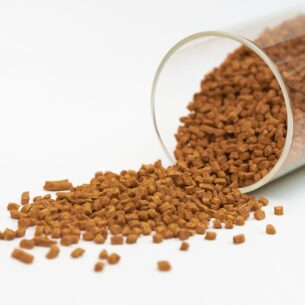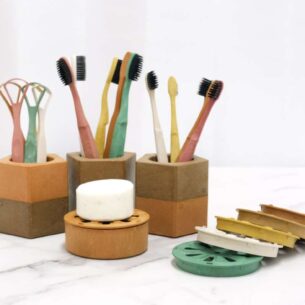Plastics have brought prosperity to mankind, but on the other hand, it has also created a waste problem.
Still, it's noteworthy that plastics are the core of the industry.
Mass production is possible and there are already many support companies.
Therefore, we developed a wood product that can be processed using plastic production facilities.
Solution
CXP Wood
Wooden goods that can be made using plastic production facilities
CXP Wood
Plastics have brought prosperity to mankind, but on the other hand, it has also created a waste problem. Still, it's noteworthy that plastics are the core of the industry. Mass production is possible and there are already many support companies. Therefore, we developed a wood product that can be processed using plastic production facilities.
That's how CXP was born.
CXP Wood
characteristics
of CXP
It is a wood-based material
As a consequence, it stores carbon for a long period of time.It is a non-toxic material
Made only from edible ingredients, it received non-detection reports of toxic substances in more than 40 tests. No toxic gases are generated during combustion as well.It is heavier than water
Mostly, CXP sinks into rivers because it is heavier than water, and for being non-toxic it doesn't pollute the environment. CXP doesn't contribute to garbage islands in the sea and doesn't harm animals and plants.It is a price-competitive material
CXP is inexpensive, so it can compete with traditional plastic products. This is the material to create goods that will help recover the environment through human consumption.It is able to be mass produced
CXP is thermoplastic and can be mass-produced, therefore being able to enter the current cheap plastic market, so anyone can use it. Everyone can help fight climate change.It does not decompose easily
CXP can resist decomposition for longer than 30 years in environments where moisture is constantly supplied. If there is no moisture at all, CXP gets carbonized. Strong sunlight promotes carbonization, turning CXP into coal. If one collects and bury CXP-made products in a wasteland, the soil quality will also have improved.
CXP Wood
It is a wood-based material
As a consequence, it stores carbon for a long period of time.It is a non-toxic material
Made only from edible ingredients, it received non-detection reports of toxic substances in more than 40 tests. No toxic gases are generated during combustion as well.It is heavier than water
Mostly, CXP sinks into rivers because it is heavier than water, and for being non-toxic it doesn't pollute the environment. CXP doesn't contribute to garbage islands in the sea and doesn't harm animals and plants.It is a price-competitive material
CXP is inexpensive, so it can compete with traditional plastic products. This is the material to create goods that will help recover the environment through human consumption.It is able to be mass produced
CXP is thermoplastic and can be mass-produced, therefore being able to enter the current cheap plastic market, so anyone can use it. Everyone can help fight climate change.It does not decompose easily
CXP can resist decomposition for longer than 30 years in environments where moisture is constantly supplied. If there is no moisture at all, CXP gets carbonized. Strong sunlight promotes carbonization, turning CXP into coal. If one collects and bury CXP-made products in a wasteland, the soil quality will also have improved.
CXP post-processing
We need the government and international community's help, and the right perception of consumers regarding CXP post-use treatment.
Instead of indiscriminately incinerating, it should be buried in the desert or wasteland. That's how you store carbon for long periods of time. Consumers should not dispose of toxic substances along with CXP prior to landfilling.
Korea has a high recycling collection rate. Nevertheless, 40% of plastics that are forwarded for recycling are exported or landfilled, while 60% reach recycling companies. Among these, about 40% actually get recycled. This means that roughly about 25% of the total amount of collected plastic is recycled, and this is a very low number. The remaining 75% either goes to landfill or gets burned. In theory, recycling is easy, but not so much in practice: oftentimes, the plastic waste is contaminated with food or other unknown substances and can't be recycled.
Of course CXP can also be recycled, but if for some reason it is not, it can be buried in a natural environment. Food waste is also not a problem, from the environmental point of view, unless it's contaminated with some poisonous substance or the amount thrown away is too much, but a little bit of it doesn't cause damage. Likewise, CXP waste that is contaminated with food residues can be buried without issues, but plastic contaminated with food residues can't be processed for recycling. CXP wood will degrade a bit, helping plants grow with nutrients released in the soil, and the remaining amount of CXP will carnobize. This method of disposal creatse a foundation to turn wastelands or deserted areas into a forest.
Garbage should no longer be a problem. This is a way to efficiently store carbon and grow forests. This is the way to help mankind survive.
CXP post-processing
We need the government and international community's help, and the right perception of consumers regarding CXP post-use treatment.
Instead of indiscriminately incinerating, it should be buried in the desert or wasteland. That's how you store carbon for long periods of time. Consumers should not dispose of toxic substances along with CXP prior to landfilling.
Korea has a high recycling collection rate. Nevertheless, 40% of plastics that are forwarded for recycling are exported or landfilled, while 60% reach recycling companies. Among these, about 40% actually get recycled. This means that roughly about 25% of the total amount of collected plastic is recycled, and this is a very low number. The remaining 75% either goes to landfill or gets burned. In theory, recycling is easy, but not so much in practice: oftentimes, the plastic waste is contaminated with food or other unknown substances and can't be recycled.

Of course CXP can also be recycled, but if for some reason it is not, it can be buried in a natural environment. Food waste is also not a problem, from the environmental point of view, unless it's contaminated with some poisonous substance or the amount thrown away is too much, but a little bit of it doesn't cause damage. Likewise, CXP waste that is contaminated with food residues can be buried without issues, but plastic contaminated with food residues can't be processed for recycling. CXP wood will degrade a bit, helping plants grow with nutrients released in the soil, and the remaining amount of CXP will carnobize. This method of disposal creatse a foundation to turn wastelands or deserted areas into a forest.
Garbage should no longer be a problem. This is a way to efficiently store carbon and grow forests. This is the way to help mankind survive.
See more of
Dongnam Realize's CXP
Realize it with Dongnam Realize.



